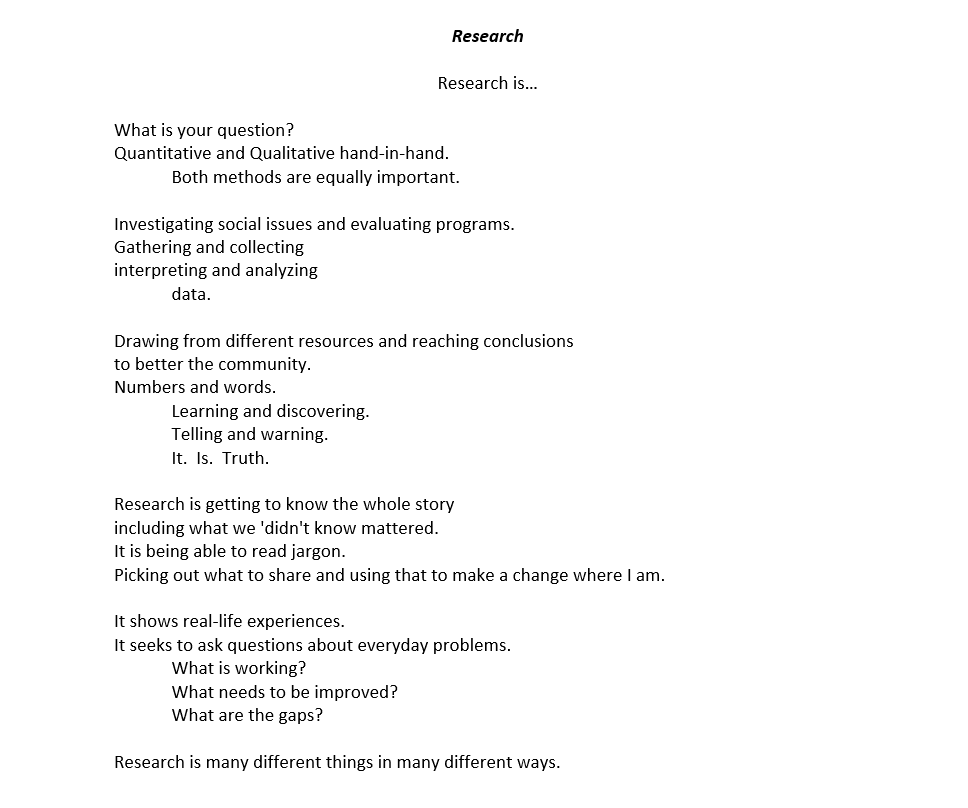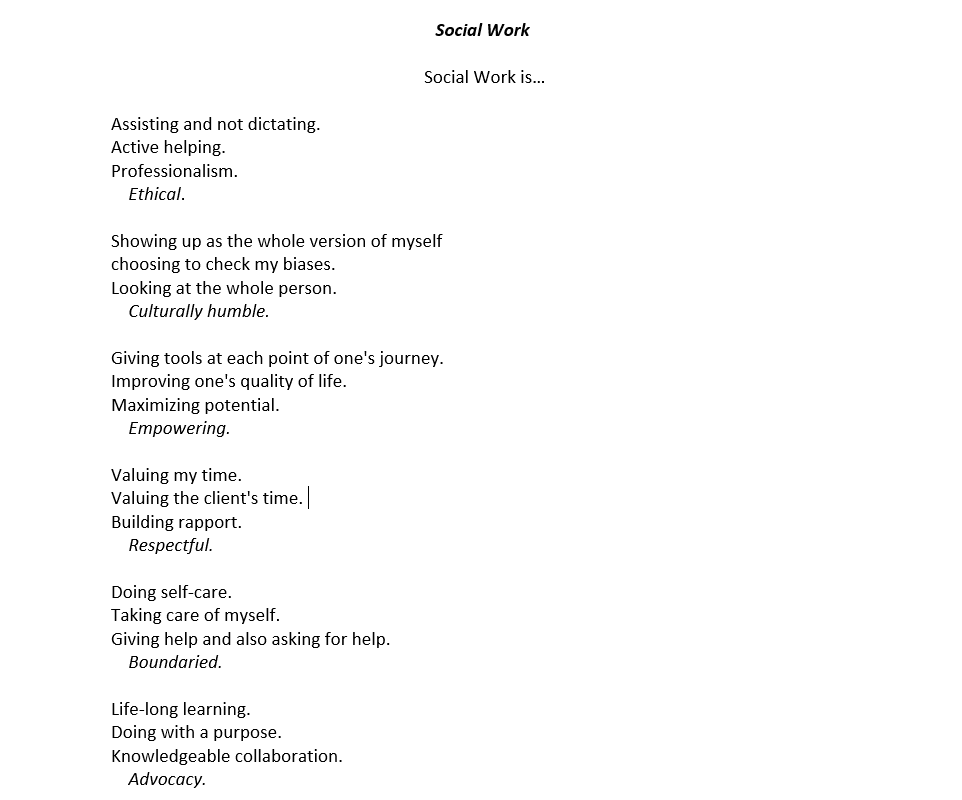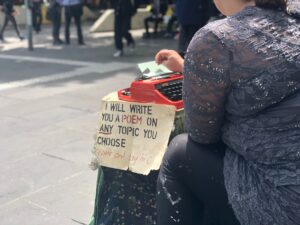The Power of Words: Using Poetic Analysis in a Social Work Research Course
Editor’s Note: This blog post was written by Amber Sutton, LICSW, ABD, a social work instructor at the University of Alabama at Birmingham, in collaboration with students from her undergraduate social work research course during the Spring 2022 semester. The students are (in alphabetical order): Iva Burdette, Jackie Chavez-Martinez, Jennifer Dussich, Courtney Kramer-Williams, Katie Kramer, Hannah Marsh, Rachel Shunnarah, Natalie Trammell, Ahmia Vain, and Ella Wolfe. In this blog post, Amber and the students share how they used poetic analysis to answer some age-old questions – What does it mean to be a social worker, and what is research? You can also read their two poems.
When agreeing to teach SW 320 Research Methods to BSW students at the University of Alabama at Birmingham (UAB), I knew I wanted to highlight alternative ways to conduct research that add an element of humanity to the data and encourage the students to use research to share power.
We started the class by reading Ann Hartman’s 1990 article, The Many Ways of Knowing. This article remains just as relevant today as it did then and has played a fundamental role in developing my relationship with research. Hartman’s editorial essay calls on social workers to recognize that each contribution adds to our knowledge and deepens our understanding. She boldly states, “there are many truths, and there are many ways of knowing” (p. 3). This article served as the foundation of the course because I wanted the students to understand that quantitative and qualitative methods are an integral part of social work research. Our profession misses out when we center on quantitative research as the only valid way of knowing.
During our very first class, I provided large post-it notes and markers. Then, allotting 20 minutes, I asked the students to answer these two questions in a way that felt most comfortable to them (words, drawings, etc.):
- What does being a professional social worker mean to you?
- How do you define research?
After the exercise, the students and I processed the activity. I asked if anyone would like to share any of their answers. We followed up the conversation by addressing any additional thoughts or hesitations that came up for them, including some things they are looking forward to learning during the semester. I saved the responses. Towards the end of the semester, after we completed the readings and discussions from the textbook, I asked the students to take about 15 minutes to answer these two questions again. They were not required to attach their name to their responses. After jotting down their thoughts, they found their initial responses (except for two students who were unable to join us for the first class) and compared their two sets of answers. We opened the discussion by comparing and contrasting their first set of answers to their second set. Did anything surprise them? Similarities? Differences? To model research, I asked for the student’s permission to collect their most recent responses and informed them that I would take their anonymous data and perform some method of analysis, where they could complete member checking and share their thoughts and feedback. All ten students agreed.
Earlier in the semester, as part of a reflexivity assignment, we used a model of the I Am From self-reflexivity activity by Ramona Beltrán (2019), which is based on Georgia Ellen Lyon’s poem “Where I’m From.” I remembered how much the students had enjoyed that poetic exercise. So, I decided to take a risk and immerse myself in poetic analysis. Poetic analysis is a creative form of qualitative research that constructs data into expressive and artful representations, and as such, poetry challenges the dominant processes of meaning-making (McKenna-Buchanan, 2017; Beltrán, 2019). Moreover, poems are accessible, easy to digest, and are legitimate ways of knowing and have been used as data sources and activist tools by several social work scholars (Furman et al., 2012; Sjollema & Bilotta, 2016; Beltrán, 2019; Beech, 2021). As the poet-activist Audre Lorde (1977) states, “poetry is not only a dream and vision; it is the skeleton architecture of our lives. It lays the foundations for a future of change, a bridge across our fears of what has never been before.”
I began the analysis by separating the two questions and reading through each student’s responses a couple of times to make sense of the data. Following the read-through, I highlighted certain words and phrases and was able to group similar findings. The phrases started to form a picture of how the students defined both research and social work, and I used those words to then create the poems.
The following week, I shared the poems in class with the students. I informed the class that the words presented had not been changed or modified by me, and we began the member checking process by allowing time for them to read through the two poems and share their thoughts about the wording, arrangement, and overall presentation. Member checking or participant validation is used as a tool to explore the credibility of results by providing participants with the opportunity to engage with and add to the interpreted data (Birt et al., 2016).
The poems were shared vis Google Docs, and it was set so that any student could edit the poems. I asked them to make revisions as they saw fit. The students did not provide edits as they collectively agreed with the presentation of the poems. The final part was ensuring that each student could recognize something they wrote since this was their work, after all. I asked the students if they could recognize some of their own words in each of the poems and the students replied yes. Some students also called out specific examples of words they had written.
The students reacted enthusiastically, and after discussing the possibility of dissemination, the students were eager to share the poems. The project symbolized everything we had discussed throughout the course, including choosing a method that makes sense to your research, the process of member checking and power-sharing during analysis, and dissemination strategies for getting our work back out into the community.
After reaching out to the BSW Program Director and getting some ideas on how to publish the poems, I shared these options with the students. I sought written consent, and students were given a choice to have their contributions published and be listed as a co-author. All ten students agreed, and it suddenly became more than just a class assignment; it became tangible and meaningful. The poems represented their individual contributions and their contributions as a classroom community – a notable finding given that COVID-19 reminded us of the importance of feeling connected with and to others.
The collective poems below represent selected responses from each of the students:


This class symbolized many firsts for me. Since it was my first time teaching a research methods course, I had never utilized poetic analysis as an in-class activity and knew that it would require vulnerability on my part and theirs. The activity illustrated research in real-time and the power of data. In some ways, the poems also strengthened the sense of community in the classroom as these were collective works.
Have you tried poetic analysis or other shared meaning-making forms to help your students? Please share your thoughts in the comment section below. We would love to hear from you.
References:
- Beech, H. H. (2021). Feminist Poetry: The Researcher’s Loom. Reflections: Narratives of Professional Helping, 27(2), 44–45. Retrieved from https://reflectionsnarrativesofprofessionalhelping.org/index.php/Reflections/article/view/1905
- Beltrán, R. (2019). “I (WE) refuse to be silenced”: Poetic self-reflexivity as a feminist tool of resistance. Affilia, 34(2), 145–150. https://doi.org/10.1177/0886109919845456
- Birt, L., Scott, S., Cavers, D., Campbell, C., & Walter, F. (2016). Member checking: A tool to enhance trustworthiness or merely a nod to validation? Qualitative Health Research, 26(13), 1802–1811. https://doi.org/10.1177/1049732316654870
- Furman, R., Enterline, M., Thompson, R., & Shukraft, A. (2012). Poetry matters: A case for poetry in Social Work Practice. Journal of Social Intervention: Theory and Practice, 21(1), 5–17. https://doi.org/10.18352/jsi.283
- Hartman, A. (1990). Many ways of knowing. Social Work, 35(1), 3–4.
- Lorde, A. (1977). Poetry is Not a Luxury. Chrysalis: A Magazine of Female Culture, (3).
- Lyon, G. E. (n.d.). Where I’m from. Retrieved from http://www.georgeellalyon.com/where.html
- McKenna-Buchanan, T. (2017). Poetic Analysis. In M. Allen (Ed.), The SAGE encyclopedia of communication research methods (pp. 1262–1264). SAGE.
- Sjollema, S. D., & Bilotta, N. (2016). The raw and the poignant: Using community poetry in research. Journal of Poetry Therapy, 30(1), 17–32. https://doi.org/10.1080/08893675.2016.1256466
How to cite:
Sutton, A., Burdette, I., Chavez-Martinez, J., Dussich, J., Kramer-Williams, C., Kramer, K., Marsh, H., Shunnarah, R., Trammel, N., Vain, A. & Wolfe, E. (2022, April 29). The Power of Words: Using Poetic Analysis in a Social Work Research Course. Teaching and Learning in Social Work. https://laureliversonhitchcock.org/2022/04/29/the-power-of-words-using-poetic-analysis-in-a-social-work-research-course/




